OUR HISTORY
BMS Scuderia Italia was born in 1980 when Giuseppe Lucchini, the founder and current owner of the company, in collaboration with some lovers, including his friend Vittorio Palazzani, decides to take part in the Italian Sport Championship with an Osella PA8 with BMW 2000 cc engine.
The car is directly bought by the Osella of Volpiano (TO) and, as for the management in the track, a little but efficient organization is created. Giorgio Francia, Alfa Romeo driver and official tester, is called to drive the car.
And satisfactions come soon, Giorgio Francia wins the Italian Championship after winning 9 races on 10 and he gains also the absolute in pair with Marazzi during the Vallelunga 6 hours, Sport-Prototype World Championship proof. The flag, under which this enterprise begins, is that of Scuderia Mirabella Mille Miglia, an old local association presided by the same Palazzani who uses the Mirabelle Racing technical structure.
In 1981 and 1982 Scuderia Mirabella Mille Miglia takes part in many Sport-Prototypes World Championship tests collecting important results as the absolute Mugello 6 hours with the couple formed by Giorgio Francia and Lella Lombardi.
In 1981 the same Lella Lombardi graduates as Sport GR6 Italian champion.In 1983 the Sport World Championship opens at the great Sport-Prototype cars of that period, including the Porsche 956-962 and the Lancia LC2 with a Ferrari engine. 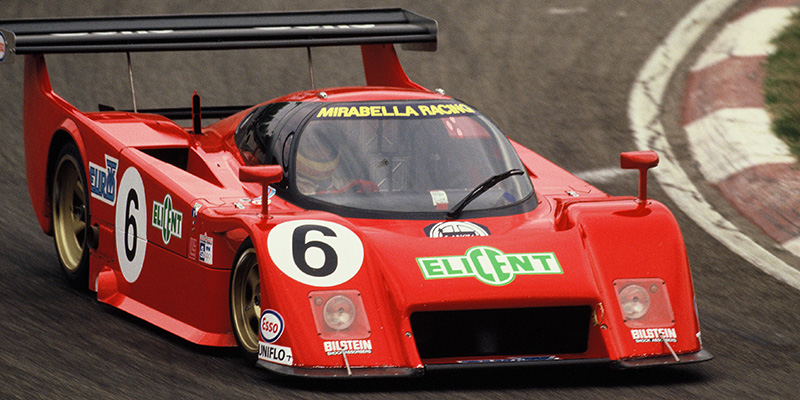
In 1983 the Sport World Championship opens at the great Sport-Prototype cars of that period, including the Porsche 956-962 and the Lancia LC2 with a Ferrari engine. With this last car Mirabella Mille Miglia appears on the European tracks. In terms of absolute speed, the car is competitive but not very reliable, especially in comparison with the German competitors. It's especially for these reasons that during the year the car takes part in only five races with the couple Giorgio Francia-Paolo Barilla.
The positive results allow the young Paolo Barilla to pass the following year to the official Lancia Maritni Cars wheels. On the contrary, for Mirabella, the head office hasn't a real interest in having a competitive sporting customer and so they decide to stop the racing.
During 1984 a sudden change in the sporting plans takes place: from the tracks of all Europe they pass to the Italian roads, in order to take part in the Italian Rally Championship. Alfa Romeo GTV 6 cylinders 2500 cc is chosen for the debut. The driver is Giacomo Bossini, a local young talent who, during the four years sporting activity with the team, obtains important results.
Another news is the creation of a direct structure which has not only executive personnel but also an own technical team. Brixia Motor Sport (BMS) is born.
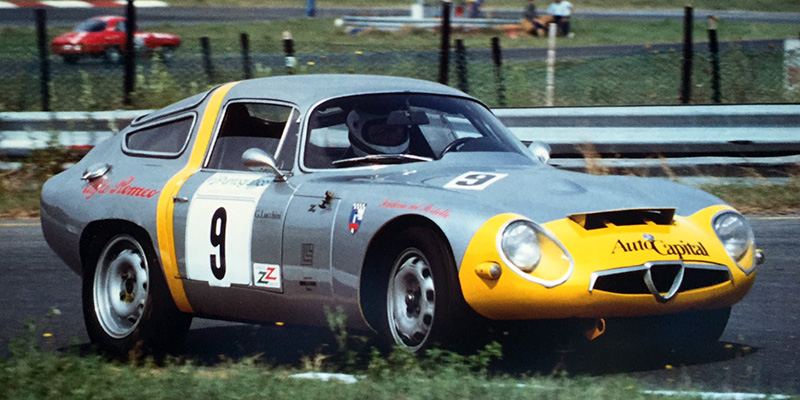 Always in 1984, the win in a FIA European Championship arrives: the one for the historical cars, with an Alfa Romeo Tubolare Zagato 1600 driven by the same owner of the team, Giuseppe Lucchini. As the results of 1985 are encouraging, they decide for a first level and very ambitious programme. The participation to the Rally Championship with an important car: the famous Lancia Rally 037, 2nd evolution.
Always in 1984, the win in a FIA European Championship arrives: the one for the historical cars, with an Alfa Romeo Tubolare Zagato 1600 driven by the same owner of the team, Giuseppe Lucchini. As the results of 1985 are encouraging, they decide for a first level and very ambitious programme. The participation to the Rally Championship with an important car: the famous Lancia Rally 037, 2nd evolution.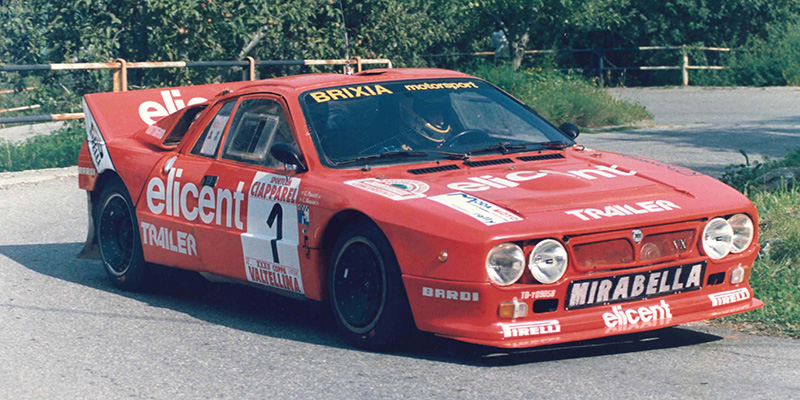 Two models are bought: one which is used, ex Martini, and one new with all the evolutions and the updating available in that moment.
Two models are bought: one which is used, ex Martini, and one new with all the evolutions and the updating available in that moment.
Between the real positive results, we have 9 victories and a CIR (Rally Italian Championship) 3rd place and the victory in the North Trophy Championship of the same year.
Bossini places under the official cars with BMW 037, but always before all the other private cars which are enrolled. In 1986 the Integral Delta S4 starts and for the 037 things are more difficult.
In 1987, Lancia 037, even if competitive again, is excluded from the most important events, for regulation problems. For this reason they change model and pass to Alfa Romeo.
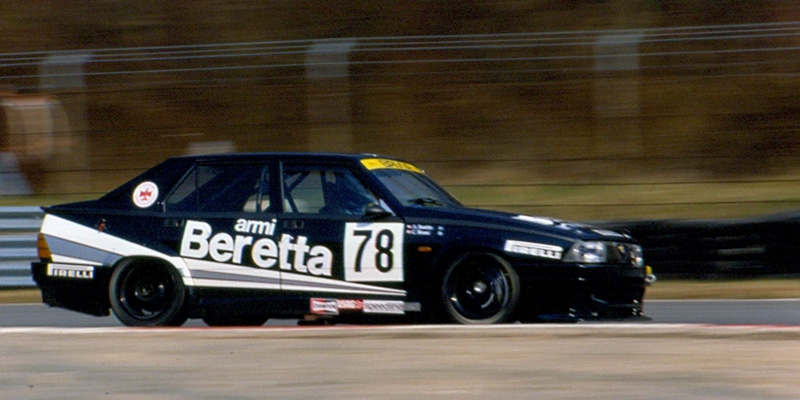 In fact, during September/October 1986, a very new prepared Gr.A. turbocharged Alfa Romeo 75 is given to BMS by the mother house.
In fact, during September/October 1986, a very new prepared Gr.A. turbocharged Alfa Romeo 75 is given to BMS by the mother house.
In October 1986 this car is therefore subscribed at the 500 km of Estoril, Portugal. This occasion is propedeutical for the contract which will be stipulated in 1987 and which provides BMS to run in the rally and in the Tourism European Championship with the new Alfa Turbo 75. Tthe race programme is required directly by the House of Arese in order to have a satellite team near the official team.
FORMULA 1
The results on the track and during the rally are not very exciting, the car is too young. During July/August 1987 the big step in the Formula 1 world is decided! A great qualitative leap that doesn't find the team unprepared. First of all, for this adventure a new corporate instrument is founded and it is dedicated only to Formula 1.
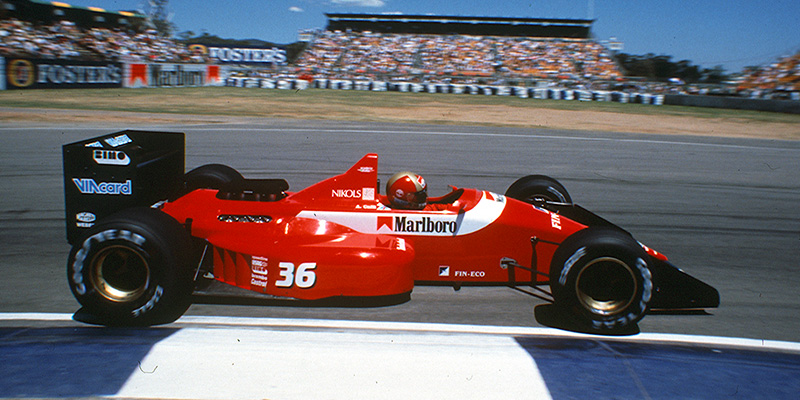 The F1 project begins thanks to the estimation and friendship relation between Lucchini, Palazzani and Gian Paolo Dallara, owner of the factory of Varano (PR). The decision is made with attention and determination and they starts working on the charming project despite the limited budget at their disposal, even if it's sufficient to hope to have good results.
The F1 project begins thanks to the estimation and friendship relation between Lucchini, Palazzani and Gian Paolo Dallara, owner of the factory of Varano (PR). The decision is made with attention and determination and they starts working on the charming project despite the limited budget at their disposal, even if it's sufficient to hope to have good results.
1988 begins with the participation of only one car given to a young and talented local driver at the World F1 Championship, Alex Caffi. After the beginning in Brazil with an old and used Dallara F3000 they start with the new BMS Dallara F188 from the S. Marino races. At first, the great results don't come but everything is good in order to make technical experience for Dallara and organizational-managerial experience for Scuderia Italia. The results are however considered as a 'force' to observe.
During the same year, Brixia Motor Sport takes part - with ups and downs - in the Italian Rally Championship with an Integral Lancia Delta, always driven by Giacomo Bossini.
In 1989 Scuderia Italia presents itself with two single-seaters called BMS F189, natural evolution of F188 with Boosted Cosworth engine. The drivers are the confirmed Alessandro Caffi and the experienced Adrea De Cesaris.
The qualitative leap is substantial. The first world points and the first satisfactions arrive: at the Montecarlo GP Alessandro Caffi wins an exciting 4th place and at the following Canadian GP Andrea De Cesaris arrives third gaining a podium that not all the today F1 teams have won yet!
The final season result sees Scuderia Italia coming at the 8th absolute place in the team championship on 16 participants! All this with a budget that today is like to that of a good international season with GT cars! In 1990 Dallara prepares a reliable single-seater, but it's maybe too similar to the previous BMS 189.
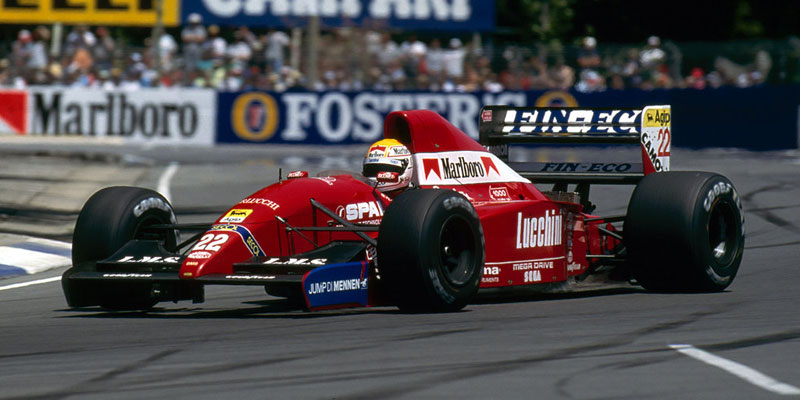 The Championship ends with results which in some cases are exciting. Unforgettable, for example, the third place in the starting grid of Andrea De Cesaris during the American GP in Phoenix, just behind Ayrton Senna!
In 1991 more horses Ford Costworth engine is not more enough – and e new chassis are needed. There aren't official houses that could give an engine to Scuderia Italia, so they trust a little, but clever English company which has made good things in F1.
The Championship ends with results which in some cases are exciting. Unforgettable, for example, the third place in the starting grid of Andrea De Cesaris during the American GP in Phoenix, just behind Ayrton Senna!
In 1991 more horses Ford Costworth engine is not more enough – and e new chassis are needed. There aren't official houses that could give an engine to Scuderia Italia, so they trust a little, but clever English company which has made good things in F1.
The constructor John Judd prepares, exclusively for BMS, a powerful and compact 10 cylindres engine. This engine allows Dallara to build a little but aggressive in the aerodynamic single-seater, typical in this period. But the engine, even if good, is extremely fragile and the general reliability isn't one of its main features.
In spite of this, Judd, J.J. Letho and Emanuele Pirro, make excellent races, so that the podium (3rd absolute) won at Imola GP, with the mytical Ayrton Senna who gains the race, is even now in the minds of the team. Other quite good performances follow, but the reliability of the engine doesn't permit other positive results.
In 1992, finally, a new 23 cylinders propulsor arrives.
During this year Ferrari, with a biennal contract, gives the team its 12 cylinders. It's surely better than the Judd one but, considering it was the one of the previous season and that during that period Ferrari hasn't the performances of today, BMS Dallara F192 results are positive but not those the team has expected. That year the drivers are Pierluigi Martini and J.J. Letho. 1993 is the last year in F1 for Scuderia Italia. The retirement comes after six years of activity, carried out in the best way for a private team that, without an engine and a technology building house at its back, couldn't compete with dignity any more. The decision is then confirmed during the following years by the consideration that the costs are so high and unacceptable that many teams left the races. After some years the Benetton family decides to withdraw and sells everything to the Renault team. This is indicative.
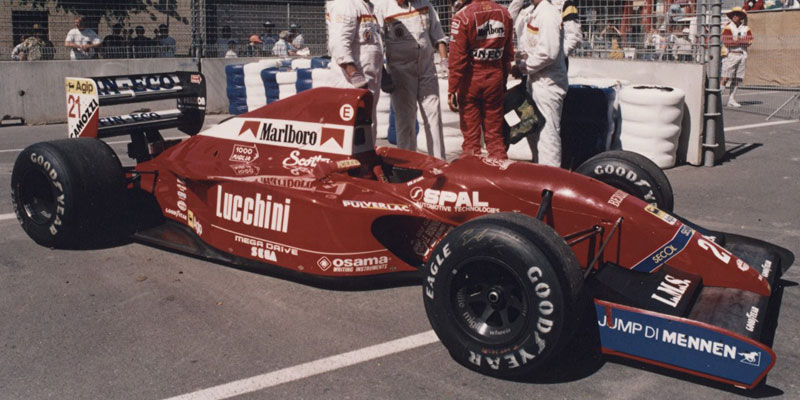 The decision to withdraw is then made easier by the bad results during the season when the chassis maker is changed from Dallara to the English Lola. This is a wrong decision but it's the extreme attempt to find a way which could allow Scuderia Italia to remain in F1 with a suitable budget.
The decision to withdraw is then made easier by the bad results during the season when the chassis maker is changed from Dallara to the English Lola. This is a wrong decision but it's the extreme attempt to find a way which could allow Scuderia Italia to remain in F1 with a suitable budget.
After the conclusion of the adventure Scuderia Italia has to reinvent a proper company and sporting strategy. First of all Brixia Motor Sport and Scuderia Italia are 'melted' in BMS Scuderia Italia.
All this because there isn't the need of having two separate structures. Our experience and the sporting results allow us to find an agreement with a motor company which proposes us to race its cars during international championships. The three-years contract with Nissan begins. They entrust us its Primera D2 in order to take part in the German Tourism Championship, the most competitive in Europe during those years.
The typical Scuderia red colour is substituted by the Nissan one. Many good drivers have passed by BMS during those years, including the ex Ferrari one Ivan Capelli. 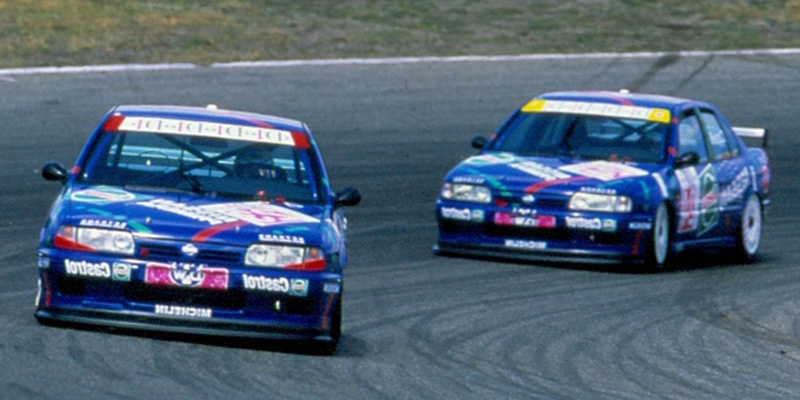 At the beginning results are disappointing but then they improve till the victory during the Arvus race. During these years Scuderia Italia makes a lot of experience.
At the beginning results are disappointing but then they improve till the victory during the Arvus race. During these years Scuderia Italia makes a lot of experience.
In 1997, after the end of the Nissan agreement, BMS Scuderia Italia decides to take part in the GT Championship, even if at a private level, with a prestigious car and interesting views. In 1996 FIA GT Championship is become very important: Porsche starts the second part of the years with a 911 GT1, a fantastic car which is at the limit of the regulations but which, at the end, is accepted.
This car dominates the last races of the 1996 assuring the German house the prospect of a winning 1997.
Some teams buy the new 911 GT1 and among them BMS Scuderia Italia, red of course and with the classic white band on the front bonnet.
The car is powerful and quite reliable, but the real problem is that, with surprise, during the Spring of 1997, Mercedes decides to enter the category with a new GT, not in commerce yet. This car is type-tested even if it's not on sale neither in road version nor in the race one. Of course, GTR has performances which are so high that Porsche GT1 becomes obsolete after the firs race. Porsche finds a remedy by coming back to the races directly with a new carbon chassis car, that's to say, with the same Mercedes extreme construction philosophy.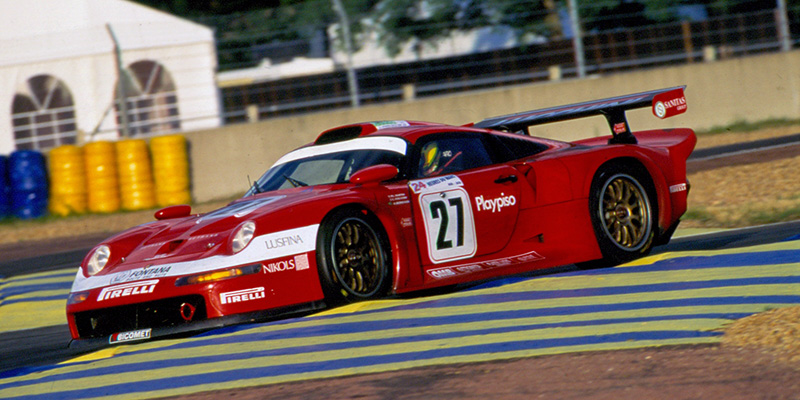
For this reason during 1997 results are bad even if BMS Scuderia Italia has made the first step in a category which some years later will give many satisfactions to the team. During 1998 BMS Scuderia Italia comes back to the tourism races with an Alfa Romeo, the house which saw it as official in 1987. It's the Italian Championship and the cars are the 155 D2 ones which have ran officially the year before.
The results, for a private team, are undoubtedly good. The drivers are Emanuele Moncini and Christian Pescatori who, after the F3 single-seater, started with a BMS Porsche GT1 in 1997. During the period 1999/2001 Scuderia Italia passes to the Ferrari prototype. The Championship is the ISRS which in 2001 becomes Fia Sport. Christian Pescatori, Emanuele Moncini, Enzo Calderari, Lilian Bryner, Angelo and Marco Zadra, Jean Marc Giunon are the drivers of the two F333.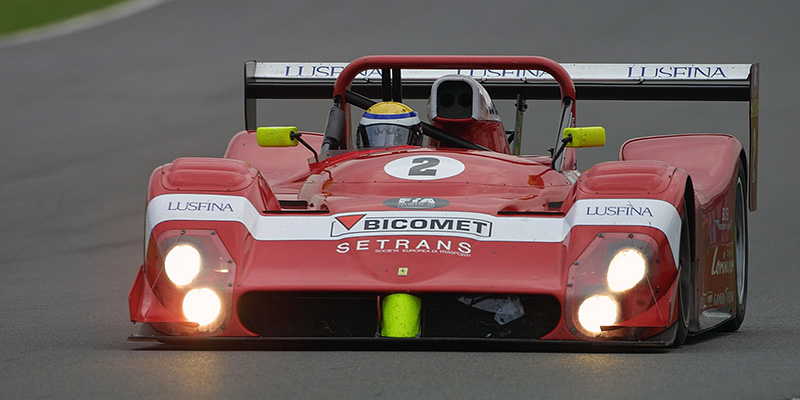
On these very nice and competitive single-seaters BMS Scuderia Italia has a period of settlement after having changed car and category every year. And results come with four victories and with the triumph in the 2001 FIA Sport Championship, with Christian Pescatori and Marco Zodra. BMS Scuderia Italia wins also the team title. These results have rewarded the day by day team working, made in order to improve a car which is already good, but which the time makes less competitive in comparison with its beginning in 1994.
FIA GT WORLD CHAMPIONSHIP
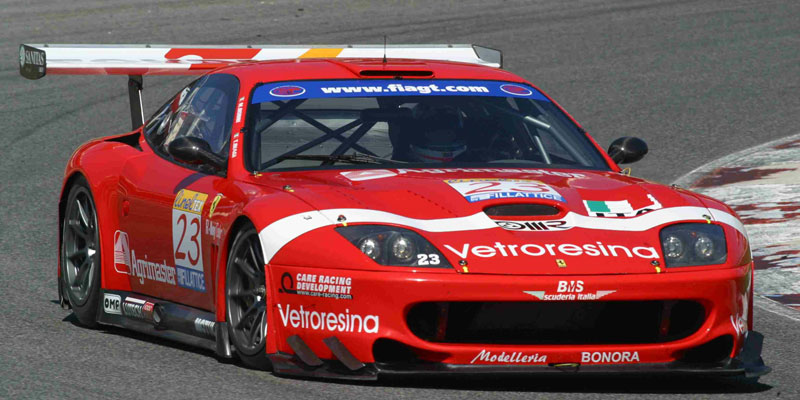 All this experience, also at an engineering level, is fundamental even in the next 'sporting cycle' which sees BMS Scuderia Italia coming back in the FIA GT Championship with Ferrari 550 Maranello, prepared by the English Prodrive and wanted by the Swiss sportsman Frederic Dor of the care Racing.
All this experience, also at an engineering level, is fundamental even in the next 'sporting cycle' which sees BMS Scuderia Italia coming back in the FIA GT Championship with Ferrari 550 Maranello, prepared by the English Prodrive and wanted by the Swiss sportsman Frederic Dor of the care Racing.
During 2002 two GT are prepared: one for Piccini-Delatraz and the other for Calderari-Bryner-Dor. The beginning is promising and it flows in four victories. The Championship escapes for little, because they lose for some technical problems the 24 hours, the most important race for its double score.
During the next years the cars are further developed by Prodrive and by the same BMS, so that during the 2003/2004 sporting seasons they obtain great results: 14 victories, including the one at the 24 hours at Le Mans in 2004 and the victory during those two years both in 2003 Drivers Championship with Bobbi-Biagi and in 2004 one with Capellari-Gollin, further the Team Championship conquered by BMS Scuderia Italia for two years.
In 2005, BMS participates and wins with two Ferrari Maranello Championship GT1 Le Mans Series, winning races and championships.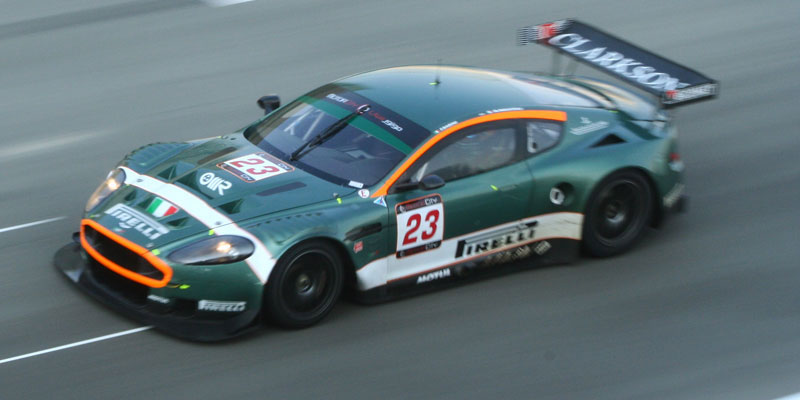
In 2006 BMS switches participating in the FIA GT Aston Martin DBR9 GT1 with two GT3 European Championship and three DBRS9. The results however even interesting can not match the extremely positive for the period 2003-2005.
2008/09 saw the return of BMS with the Ferrari participating in the FIA GT Championship with two 430 GTC Berlinetta (GT2). Good results with a win in the 24 Hours of Spa and two second places in the 24 Hours of Le Mans (GT2 class).
Good results with a win in the 24 Hours of Spa and two second places in the 24 Hours of Le Mans (GT2 class).
In 2010 BMS has participated in two major endurance races for GT cars in the world: the 24 Hours of Le Mans and the 24 to SPA. In the classic French BMS was ranked third in the GT2 class while in Belgium took the overall win. In both contests, Italy BMS Scuderia raced the Porsche Motorsport as Team Supported.
NON SOLO CORSE
 During the period from 1999 to today Scuderia Italia has grown and has become a Company where, further the Competition Department, two new complementary sectors collaborate: the Automotive and the Engineering ones.
During the period from 1999 to today Scuderia Italia has grown and has become a Company where, further the Competition Department, two new complementary sectors collaborate: the Automotive and the Engineering ones.
Today BMS gives its clients its experience in the designing, in the testing, industrialisation and production of pieces and components for the world car industry.
In the racing sector BMS takes part in races and international Championships by its own and by planning its sporting clients.
During its 25 years of sporting, planning and management in the car world activity, BMS Scuderia Italia has always given attention to the future. It has run new cars, has helped and launched young drivers, most of all Italians, and has demonstrated to be one of the most interesting realities of our country. These have been our first 25 years. The next will be rich in satisfactions and success.